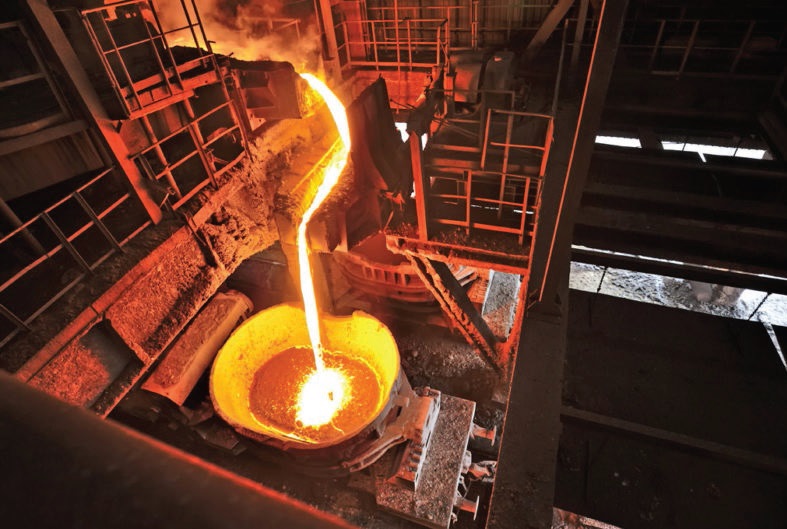Hexagonal close-packed high-entropy alloy
Dr. Neil Canter, Contributing Editor | TLT Tech Beat August 2017
The new material is radiation resistant, making nuclear reactors a potential application.
KEY CONCEPTS
•
A new high-entropy alloy has been developed by converting a material with a face-centered cubic atomic arrangement to a hexagonal close-packed structure under high pressure.
•
After the pressure is relieved, the resulting alloy contains both face-centered and hexagonal close-packed structures leading to the potential to design materials with specific hardness and ductility properties.
•
The transition between structures is probably high because it is hard for atoms to move around and diffuse.
THE DEVELOPMENT OF NEW ALLOYS continues as researchers strive for materials that combine properties such as strength and ductility that are not normally found together in most conventional alloys. Most alloys usually consist of one metal in a high percentage, which limits the available alloy compositions.
In a previous TLT article, a new class of high-entropy alloys that contains five or more metals in roughly equal number was discussed (
1). For the example of five metals, each element would be present in a high-entropy alloy at a concentration of 20%. A high-entropy alloy based on mixing equal percentages of aluminum, lithium, magnesium, scandium and titanium was discussed. The researchers who prepared this high-entropy alloy found that it displayed a higher strength-to-weight ratio than any other existing metal.
Dr. Cameron Tracy, post-doctoral researcher in the department of geological sciences at Stanford University in Stanford, Calif., says, “High-entropy alloys have enormous potential because there are many ways to combine metals in equal concentrations. They can exhibit properties not found in conventional alloys. High-entropy alloys that have been prepared display greater fracture toughness (or strength per unit mass) than nearly all conventional alloys.”
A second advantage for high-entropy alloys is the wide variety of metals potentially will enable researchers to develop materials with many different combinations of properties. Tracy says, “With the development of high-entropy alloys, researchers are not constrained by having to work with specific elements on the periodic table.”
The initial types of high-entropy alloys produced have originated from a variety of metals but have been limited by their lattice structure. Tracy says, “Most of the high-entropy alloys developed either consist of face-centered cubic or body-centered cubic atomic arrangements. Face-centered cubic materials exhibit high symmetry, which means that planes of atoms can readily move relatively to one another. This leads this type of alloy to be highly ductile in nature.”
Few high-entropy alloys to date have been present in hexagonal close-packed structures and those that are typically contain uncommon and expensive elements. Tracy says, “The appeal of hexagonal close-packed alloys is that they are lower symmetry systems and tend to be very hard and brittle.”
Ideally the way to develop a versatile high-entropy alloy is to combine high strength with good ductility. In effect, can a material that is present in both the face-centered cubic and hexagonal close-packed orientations be prepared? Such a material has now been developed.
HIGH PRESSURE
Tracy and his fellow researchers decided to take a well-known high-entropy alloy that was prepared from an equimolar mixture of chromium, manganese, iron, cobalt and nickel and compressed this material under increasing pressure to produce a slow transformation from a face-centered cubic to a hexagonal close-packed structure. He says, “We selected this particular high-entropy alloy because it has been widely studied over the past decade and exhibits such positive characteristics as good corrosion resistance, oxidation resistance and strength.”
The alloy is prepared by arc-melting the metals under an argon atmosphere followed by drop-casting to produce an ingot. High-pressure experiments were performed by taking powder from the ingot and placing it in a symmetric, diamond anvil cell in which the material is squeezed between two ultra-hard diamonds.
X-ray diffraction showed that a transformation to a hexagonal close-packed structure starts when a pressure of 14 gigapascals is applied to the high-entropy alloy. The researchers increased the pressure to a maximum of 54 gigapascals. As the pressure increased, the ratio of hexagonal close-packed to face-centered cubic material increased.
When asked about the reasons for using high pressure, Tracy commented that his background in studying geology under high pressures in the Earth’s core where metals are present led to the current work evaluating high-entropy alloys. He says, “We felt high-entropy alloys have unique thermodynamic and magnetic properties that can change under pressure.”
The breakdown in magnetism under high pressure appears to be very important in enabling this phase transformation to occur. Tracy says, “Computational analysis shows that the disappearance of magnetism can promote a change from a face-centered cubic to a hexagonal close-packed structure under ambient pressure. The application of pressure to a material typically reduces its magnetism. As the magnetism of this high-entropy alloy breaks down at high pressure, the order of the alloy also breaks down as planes of atoms slowly shift into a hexagonal close-packed configuration.”
Once the pressure is relieved and the alloy reverts to ambient pressure, a segment of the hexagonal close-packed structure moves back to a face-centered cubic, but the high-entropy alloy retains a good deal of the hexagonal close-packed structure. Tracy says, “This behavior is unusual because in most other cases the metal alloy will completely revert back to its original state. We are not sure why this specific high-entropy alloy is different. One theory is that the hexagonal close-packed structure is in a metastable state. To see if this is the case, we are leaving samples at ambient pressure for a few years to see if the high-entropy alloy reverts back to a face-centered cubic structure.”
Tracy believes that the move to the hexagonal close-packed geometry leads to a distorted structure where it is hard for atoms to move around and diffuse. The barrier for moving to a face-centered cubic could be energetically high.
The slow transition between phases may enable the ratio of the face-centered cubic to hexagonal close-packed to be adjusted to vary the hardness and ductility to meet specific applications. This may lead to the commercialization of such alloys (
see Figure 3). One application is for use in nuclear reactors because high-entropy alloys are very resistant to radiation damage.
 Figure 3. High-entropy alloys produced by manipulating the arrangement of the atoms could lead to unique materials that could be used commercially in applications where ferrous alloys are commonly used. (Figure courtesy of Stanford University.)
Figure 3. High-entropy alloys produced by manipulating the arrangement of the atoms could lead to unique materials that could be used commercially in applications where ferrous alloys are commonly used. (Figure courtesy of Stanford University.)
Future work will be done to see how subjecting the face-centered cubic high-entropy alloy to elevated temperatures (ranging from 5-1,000 C) while under pressure affects the phase transformation. Tracy says, “Elevated temperatures have been found to also decrease magnetism.”
Other work will include evaluating different high-entropy alloys under high pressure and evaluating the mechanical properties of these alloys. Additional information can be found in a recent article (
2) or by contacting Tracy at
cltracy@stanford.edu.
REFERENCES
1.
Canter, N. (2015), “High-entropy alloys,” TLT,
71 (3), pp. 14-15.
2.
Tracy, C., Park. S., Rittman, D., Zinkle S., Bei, H., Lang, M., Ewing, R. and Mao, W. (2017), “High pressure synthesis of a hexagonal close-packed phase of the high-entropy alloy CrMnFeCoNi,”
Nature Communications,
8, Article Number: 15634.
 Neil Canter heads his own consulting company, Chemical Solutions, in Willow Grove, Pa. Ideas for Tech Beat items can be sent to him at neilcanter@comcast.net
Neil Canter heads his own consulting company, Chemical Solutions, in Willow Grove, Pa. Ideas for Tech Beat items can be sent to him at neilcanter@comcast.net.